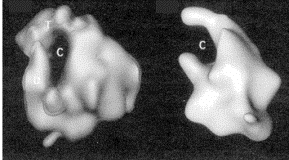DNA polymerase uses a sliding clamp in order to replicate DNA. RNA polymerase does not require one. What allows RNA polymerase to hold on to DNA just like DNA polymerase?
1 Answer
$\begingroup$
$\endgroup$
6
The structure in the presence of s (holoenzyme) is on the right; note the open channel for DNA binding. The structure in the absence of s (the core enzyme) is on the left. Note that the channel is now closed, as if the fingers and thumbs of a hand now closed to make a circle. This striking conformational change that occurs when s dissociates is thought to confer high processivity on the RNA polymerase.
-
$\begingroup$ DNA Polymerase III Holoenzyme has processivity of 500,000 bases. High isn't a number, $\endgroup$– AMRCommented Dec 12, 2015 at 6:21
-
1$\begingroup$ If you have nothing to add to the discussion and if you continue criticizing other people's answers without giving a proper explanation to the question, then you really shouldn't be using StackExchange. Also, you still haven't corrected the error in the question. $\endgroup$ Commented Dec 12, 2015 at 6:37
-
$\begingroup$ And here is another point that you are missing. RNA polymerase need only associate with the template strand of DNA and transcribe from that, where as DNA polymerization is a far more complex process involving leading and lagging strand synthesis, laying down or RNA primers, producing Okazaki fragments and performing exonuclease error correction with DNA polymerase working with both strands of DNA at the same time. $\endgroup$– AMRCommented Dec 12, 2015 at 21:38
-
$\begingroup$ Perhaps you can add some details on processivities of DNA and RNA polymerases. This will clarify the point. Also cite references for those. BioNumbers is a good place to look for figures such as these. $\endgroup$– WYSIWYGCommented Dec 14, 2015 at 9:47
-
$\begingroup$ @AMR DNA-polymerase, unaided by sliding clamp has a low processivity. Highest seems that of viral polymerases (7200 for EBV). $\endgroup$– WYSIWYGCommented Dec 14, 2015 at 9:53

